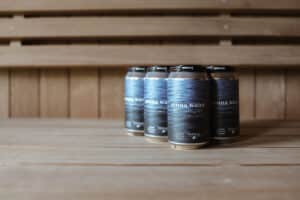Historically, sauna traditions have been crafted from the materials that surround them – wood from local trees, stones from local soils, water from nearby sources.
But these days, saunas are typically built with commodity building materials that have little to do with their location. Mass timber is helping us return to that more sustainable tradition, and inspiring a beautiful modern design language at the same time.
Mass Timber, also known as CLT or cross-laminated timber, is changing the way we think about sauna and more specifically, sustainability, in modern construction. “CLT provides an alternative to light frame construction that sequesters carbon and reduces our environmental impact,” says Joel Vikre, co-founder of Cedar and Stone.
CLT is composed of farm-grown, fast-growing timbers sourced from sustainable forests in North America. The panels we use are made primarily from Black Spruce. These forests have been thriving over the past 50 years, absorbing carbon dioxide, releasing oxygen, and locking carbon within the wood fibers.

Understanding the Environmental Impact of Mass Timber
CLT is an environmental improvement over other forms of construction in several ways. The first element to understand is embodied carbon. This is the carbon it takes to extract, manufacture, install, and eventually demolish and dispose of a product. Wood products have a leg up here because they are relatively energy efficient to produce compared to other products. In the case of a sauna, CLT is replacing other building materials with higher embodied carbon.
The second is operational carbon. This is the amount of energy it takes to operate a building over its life cycle. Here a CLT sauna is roughly comparable to a similar stick built sauna.
And third is biogenic carbon. This is the amount of carbon stored in the wood itself, from its harvest all the way through to the end of life of the building. This is where a CLT sauna really shines, because of the higher quantity of wood built into a lasting structure than other materials.
A Tailored Solution for Sauna
But CLT does more for a sauna than just reducing its environmental impact. Its exceptional structural capabilities make it a great material for buildings that will be transported already assembled. Its strength also opens up design options that are hard to put into practice with other materials, such as the double overhangs featured in some of our standard models.
CLT’s thermal mass is another advantage. “CLT is kind of a magical material because it absorbs and radiates heat slowly, creating a nice even heat,” shares Joel Vikre.
Lastly, CLT is a great material for moisture management. “With CLT we can build a wall assembly that doesn’t have any impermeable vapor barriers, which means it can dry out. So, in terms of longevity it’s going to make us a longer-lasting wall assembly that’s not as vulnerable to moisture,” says Vikre.

Pioneering Uses of CLT
We take pride in being pioneers in the use of cross-laminated timber for small buildings and saunas in North America. But we didn’t start blind. Beginning from European applications of the material, we built and tested CLT in commercial settings before making it available to our customers. We have several CLT saunas and other small buildings, including instrumented test saunas, in heavy commercial operation to this day. We even have a sauna barge on Lake Superior with CLT walls.
Not only are these buildings wearing well, they are a pleasure to be in. “Mass Timber creates sustainable, long-lasting spaces that benefit both the environment and ultimately, our clients,” shares Justin Juntunen, CEO and Co-Founder of Cedar and Stone Nordic Sauna.
“We’re a stress-destroying company,” said Juntunen. “And we also want to build as sustainably as possible. Our customers want something beautiful and they want saunas produced in America. We’re trying to create a vertically integrated system with locally sourced materials.”
Mass Timber is not merely a sustainable choice; it embodies a commitment to a greener future while enhancing the quality and longevity of our structures. Embracing this innovative material is one of the ways we are paving the way for a sustainable and resilient built environment, ensuring a healthier planet for generations to come.


Check out our “Why We Build” Playlist on YouTube to learn more.
Follow along with us as we revolutionize the way we build for a sustainable future.







